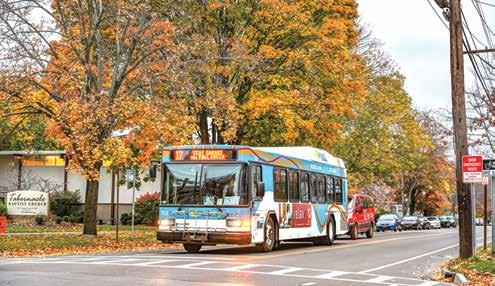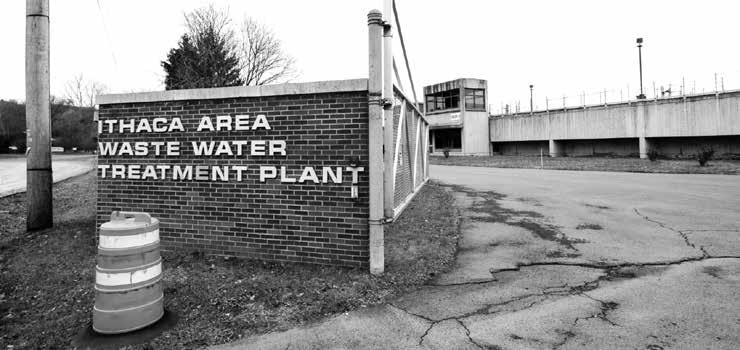


























By Grace “Gray” Reed
Tompkins County will add two new electric-diesel hybrid buses to TCAT’s current fleet after winning a $1.2 million Low-No Grant Program award on July 9. The funding comes from a $1.5 billion federal spending package organized by the Biden Administration.
The buses, which are not expected to be introduced for at least another year, will replace two older diesel buses in an effort to reduce carbon emissions. The move follows the pause of TCAT’s seven electric buses in April after one of their frames separated from its axle while on a lift and deemed “unfit for service.”
Matthew Rosenbloom-Jones, the General Manager for TCAT, expressed that with the future addition of the two new hybrid buses, passengers can expect higher quality service from the public transportation operator.
“They’ll result in more reliable service,” Rosenbloom-Jones said. “You know, it will increase our ability to run more frequent service as well, as they are going to be replacing vehicles that are much older and much less reliable and are very, kind of, worn out.”
TCAT has been struggling for some time to return to pre-pandemic levels of ridership. April’s decrease in available buses forced the company to further reduce service, inconveniencing those who rely on the transportation service.
Prior to the pulling of the seven electric buses from service, TCAT expressed

plans to have a carbon emission-free fleet by 2035. While this goal is now postponed, it maintains the hybrid buses will contribute to lowering overall emissions in Tompkins County.
“By nature, public transit reduces carbon emissions because it has people using communal transportation instead of single-occupancy vehicles which are very, very bad for the environment,” Rosenbloom-Jones said. According to a press release, TCAT claims any large transit bus can replace up to 60 single-occupancy vehicles on the road.
As it waits for the new hybrid additions, TCAT is working toward improving its current fleet by hiring new team members
and providing training to improve overall performance. Rosenbloom-Jones said TCAT is spending a significant amount of financial resources to ensure riders continue to be met with quality service.
“We’re hiring mechanics and maintenance staff at a pretty fast pace and we are relying heavily on outside contractors to help maintain our vehicles,” Rosenbloom-Jones said. “Some of our older buses are nearing 350,000 miles, and a vehicle with that much mileage requires a significant amount of maintenance to stay running today.”
The fall service period will begin on Aug. 18 and will include the 14S West Hill shopper, as well as increased weekend and night trips.
The Tompkins County Emergency Communications Center handled a record number of calls during a severe weather event this week, with dispatchers managing 455 calls for service over a 24-hour period.
A line of severe thunderstorms swept through the area on July 15, bringing heavy rain and high winds. The majority of the calls received between the afternoon and late evening hours were related to trees and wires down.
“I want to extend my thanks and gratitude for the exemplary performance demonstrated
by our 9-1-1 Center personnel,” said John Halaychik, Assistant Director-911 at the Department of Emergency Response. “I believe the 455 calls for service is the highest singleday volume we’ve experienced in the last 10 years, if not ever.”
Halaychik commended the handling of the situation by the dispatchers and first responders.
“The way situations, communications, and notifications were made and handled was top notch,” he said. “Everyone involved is to be commended for their professionalism and actions, both in the 9-1-1 Center and those
first responder personnel in the field, who — in their feedback to us — were extremely grateful of the effort and coordination.”
To manage the overflow of 9-1-1 calls related to the storm, the Cortland County Department of Emergency Response and Communications provided assistance.
The storm produced inch-sized hail, caused severe tree damage, and left thousands of NYSEG customers without power. As of Thursday morning, fewer than 200 customers in Tompkins County remained without power. Fortunately, there were no reports of injuries.
F r EE lan CE rs : Barbara Adams, G. M Burns, Jane Dieckmann, Charley Githler, Ross Haarstad, Steve Lawrence, Marjorie Olds, Henry Stark, and Arthur Whitman
THE ENTIRE CONTENTS OF THE ITHACA TIMES ARE COPYRIGHT © 2024, BY NEWSKI INC.
All rights reserved. Events are listed free of charge in TimesTable. All copy must be received by Friday at noon. The Ithaca Times is available free of charge from various locations around Ithaca. Additional copies may be purchased from the Ithaca Times offices for $1. SUBSCRIPTIONS: $89 one year. Include check or money order and mail to the Ithaca Times, PO Box 27, Ithaca, NY 14851. ADVERTISING: Deadlines are Monday 5 p.m. for display, Tuesday at noon for classified. Advertisers should check their ad on publication. The Ithaca Times will not be liable for failure to publish an ad, for typographical error, or errors in publication except to the extent of the cost of the space in which the actual error appeared in the first insertion. The publisher reserves the right to refuse advertising for any reason and to alter advertising copy or graphics deemed unacceptable for publication. The Ithaca Times is published weekly Wednesday mornings. Offices are located at 109 N. Cayuga Street, Ithaca, NY 14850 607-277-7000, FAX 607277-1012, MAILING
(1972–1978) and The
By Mark Syvertson QUESTION OF THE WEEK:
WHO’S THE G.O.A.T. (GREATEST OF ALL TIME) IN YOUR OPINION?





By Matt Dougherty
On Thursday, July 18, a New York appellate court ruled in favor of allowing Seneca Lake Guardian (SLG) to challenge a controversial permit granted by the New York State Department of Environmental Conservation (DEC). This permit, issued to the solid waste facility County Line, would permit liquid waste discharge containing dangerous “forever chemicals” known as PFAS (per- and polyfluoroalkyl substances) into Cayuga Lake. PFAS are notorious for their persistence in the environment and their potential to cause severe health issues, including cancer and damage to the immune, reproductive, and nervous systems.
In October 2022, SLG sued the DEC for allowing County Line to discharge leachate containing PFAS into the Ithaca Area WasteWater Treatment Facility (IAWWTF). SLG accused the facility of discharging leachate into Cayuga Lake while lacking the equipment necessary to remove PFAS from the waste. Activists say this discharge poses a significant threat to community members who rely on Cayuga Lake for swimming, fishing, and drinking water.
The Supreme Court for Tompkins County initially dismissed SLG's lawsuit, claiming the group lacked standing because it was speculating about potential harm from PFAS. At the time the lawsuit was dismissed, Assistant Superintendent of Water & Sewer Scott Gibson said that allegations of untreated leachate containing PFAS being discharged into the lake were “simply untrue.” However, the Appellate Division

for the Third Judicial Department reversed this decision on Thursday, recognizing that the concerns raised by SLG were legitimate.
“We are thankful that we can now move forward with our lawsuit against NYS-DEC’s unjustified permit approval for toxic waste discharge on our lake. Cayuga Lake is the longest of New York’s glacial Finger Lakes and serves to cool us during hot summer days and is a major source of our drinking water,” said Yvonne Taylor, Co-founder of Seneca Lake Guardian. “With DEC’s permit, a solid waste facility was granted a permit to discharge PFAS-containing liquid, a toxic chemical the State of New York has already banned from other sources. It does not belong in our drinking water, and we are here to ensure polluters stay out.”
The appellate court's decision underscores the right of communities to challenge regulatory decisions that may harm public health and the environment. Hillary Aidun, senior associate attorney at Earthjustice, expressed optimism about the upcoming legal battle.

“As the appellate court made clear, people who drink water from a lake have every right to challenge decisions that could pollute that lake,” said Aidun. “We look forward to showing that the Department of Environmental Conservation has to follow its own waste management regulations and ensure that PFAS is properly handled without harming New Yorkers’ health and safety.”
This legal development coincides with a comprehensive report published in April by the Ithaca College EcoTox Laboratory detailing the presence of several PFAS chemicals in the Ithaca Watershed. The report is based on extensive testing conducted since 2019 by the Ithaca Area Wastewater Treatment Plant, City of Ithaca Water Treatment Facility, Cornell Water Filtration Plant, and Bolton Point Drinking Water Facility to monitor these persistent chemicals.
The report reveals significant findings from various water facilities in Ithaca. The Ithaca Area Wastewater Treatment Plant detected PFBS and PFHxS in its influent, effluent, and biosolids samples, alongside thirteen other PFAS compounds. In contrast, the City of Ithaca Water Treatment Facility, Cornell Water Filtration Plant, and Bolton Point Drinking Water Facility reported no detectable PFAS compounds.
The compounds of greatest public concern, PFOA and PFOS, were not detected in any drinking water samples, though they were found in wastewater samples. According to the report, the detected compounds are reportedly “well below those associated with health effects in animal studies.”
The report highlights the detection of two PFAS compounds, PFBS and PFHxS,
“As for Commons Concerns, I have been down there and borne witness to all that was said; the skateboarders, the bicyclists, the pot smoking, the alcohol use, the over development, etc. I have also heard stories first hand by friends who have said they were either followed or chased by ne’er -do-wells looking for money or drugs early in the morning or in the evening. I rarely go down to The Commons except for the occasional festival. I think it is a project that has: a) sorely failed, and b) is definitely in need of some sort of supervision. The idea was a lovely one but it just wasn’t for Tiny Town, and that was appaent from the start. Now with all of the large buildings that have gone up around it, it is even less appealing, (whose bright idea was that anyways?). The only time The Commons seems to get it’s full usage is when there is a festival. So what is that? 4 maybe 5 times a year? It is sad and it is a dangerous place as well.....” — Suzanne Pedersen
“Suburban shopping malls were a brilliant innovation in their day partially due to shoppers' aversion to crime and general anti-social behavior described in this piece. But the malls were “sterile”. Entrepreneur Les Wexner then conceived of and built the Easton Center in Columbus OH which attempted to recreate positive aspects of traditional “downtown” but without the downsides. It was a huge success and had been copied endlessly around the country. A key point is that the entire “downtown” of the Easton Center is legally private property which makes it possible to “police” behaviors that annoy the majority of patrons.” — Steven Baginski
“I am finding it difficult to understand Congressman Marcus Molinaro’s stand on women’s rights. He seems to have switched to a more moderate position now that he is battling for re-election. Over the years Marcus Molinaro has voted to prohibit Medicare aid to be used for abortion; he has opposed the Reproductive Rights Act that codified Roe v. Wade; he has supported a federal ban on abortion. In Congress he voted to punish medical doctors who provided abortions and supported a bill that would restrict reproductive health care for military service members and their families.
Molinaro has ties to crisis pregnancy centers (CPCs) giving $2,050 of his cam-

paign funds to a crisis pregnancy centers that often dupe women seeking advice about unwanted pregnancies.
In March of 2024, he was in favor of a national abortion ban, until 17 weeks, and totally against any late term abortion— even when the life of the mother is at stake.
Now, in the summer of 2024, in stiff competition with Democrat Josh Riley to retain his House seat, Molinaro claims that he would support IVF, mifepristone, and would vote against a national abortion ban.
Which Marc Molinaro should we trust?
Do we look at his past actions, voting against the rights of individuals to make their own decisions about their bodies, or his statements to do otherwise? If he were reelected, would Rep. Molinaro keep his word—or are they empty campaign promises?
I think this matters.” — Carol Kammen
“In the July 17-23 Ithaca Times Shelly Neuman asks if Cornell’s Lake Source Cooling (LSC) system contributes to harmful algae blooms by returning warmer water to Cayuga Lake. While this may indeed be true, another problem is probably even more serious: the movement of soluble reactive phosphorus (SRP) from deeper in the lake to the south end of the lake. SRP is a nutrient for plant growth including harmful algae blooms. Cornell's own data (when it was still published) showed that LSC added about 7% of SRP to the south end of the lake on a yearly basis and about 50% during the summer months, when algae blooms occur. The Tompkins County Environmental Management Council warned both Cornell and the Department of Environmental Conservation, which regulates LSC, about this, but both refused to do anything about it. The solution is relatively simple and inexpensive: move the out fall pipe for LSC further out into the deeper part of the lake, thus returning the SRP (and warmed water) to where it should be. Cornell has refused to do this, apparently because it would expose its damage to the lake and affect its carefully cultured reputation.” — Herb Engman
“I am writing in support of the effort to create a local minimum wage that is a Living Wage.
A minimum wage that is a living wage is probably the most powerful step we could take to increase economic equity in our county. But I want to make clear that this economic step has consequences far beyond the number in the income column. When I heard sociologists Richard
Wilkinson and Kate Pickett speak on the harmful effects of inequality, and the benefits of greater equality, I was very impressed that their research supported what I had experienced living in Ghana and Costa Rica. In those more economically equitable societies, I felt less stress and greater happiness in the communities around me. Wilkinson and Pickett document these connections in their powerful books, The Spirit Level: Why Greater Equality Makes Societies Stronger (2009), and The Inner Level: How More Equal Societies Reduce Stress, Restore Sanity and Improve Everyone’s Well-Being (2018). The authors provide extensive statistical evidence that unequal societies are responsible for less fulfilling personal lives and in turn, harm public health and education, and increase criminal behavior and lower life expectancy. It excites me that we can make a difference not only to our fellow county residents who have low income, but that we can improve the well-being of our whole community by legislating a living wage in our county.” — Ruth
Yarrow
“There are many inaccuracies in Johnny Kampis’s letter about the County’s broadband plan. The biggest inaccuracy is that the County will NOT be operating a government-owned network. It will be privately-owned, and funded almost entirely by federal and state grants and by a local, private internet service provider. The County is currently contributing $100,000 out of a $7.5 million project, and may even be able to get the $100,000 refunded. There may be some future County costs, but they will be very small compared to the total project cost. And the result will be broadband access for every single address in Tompkins County.
PS: Johnny Kampis works for a conservative think tank in Alabama.” — Dan Klein
“I appreciate you sharing your recent review. I’ll admit, I don’t typically read these types of restaurant reviews, so don’t have much to compare it to, but I found yours very comprehensive and answered every question I typically have before trying a new restaurant. You also seem very trustworthy in your writing, highlighting the positive and negative, so I feel I can trust your opinions. I’m sure your readers feel the same way and appreciate your help in making menu decisions. Lastly, as a fan of Greek mythology, I particularly appreciated your introduction. Great writing, and a nice read!” — Anonymous Reader

The City of Ithaca is in the midst of discussions regarding a resolution that would mandate Bird Safe Infrastructure to be used in new construction projects in an effort to reduce bird casualty rates.

Downs
A global technology outage caused by an update issued overnight by cybersecurity firm CrowdStrike shut down several local services in the City of Ithaca and Tompkins County last Friday.

Tompkins County has begun its search for a new County Administrator, following the announcement of current Administrator Lisa Holmes’ retirement at the end of the year.

Reports from the NYS Board of Elections show that Republican challenger Mike Sigler raised more money than Democratic incumbent Lea Webb during the latest reporting period, which covers mid-March through mid-July. Sigler raised more than $166,000 while Webb raised just under $41,000.
IF YOU CARE TO RESPOND to something in this column, or suggest your own praise or blame, write news@ithacatimes. com, with a subject head “U&D.”
Should the City look for ways to help developers convert unused office space into housing?
66 . 1 % Yes.
25.4% No.
8.5 % I don’t care.

Should the City of Ithaca pass a resolution to mandate Bird Safe Infrastructure in new construction?
Visit ithaca.com to submit your response.
By Kira Walter
As July blossoms flourish, Greenstar Co-op’s FLOWER discount program is expanding amongst summer petals this season. On Wednesday, July 17th, the beloved Ithaca Grocery store welcomed Double Up Food Bucks, a statewide initiative that lets shoppers purchase twice as much produce for their dollar. Politicians and food justice activists congregated briefly outside of Greenstar’s Cascadilla Street location to celebrate the launch of DUFB with live music and drinks.
While swept up in the festivities, Greenstar General Manager Jeff Bessemer expressed his excitement to the Times.
“It's going to allow so many people to buy great local produce because it's just so much more available,” he said.
Bessemer has managed FLOWER since beginning his position two years ago, finding innovative ways to make groceries more accessible for all members of the Ithaca community. An acronym for Fresh Local & Organic Within Everyone’s Reach, the program extends to SNAP users and customers receiving financial assistance from government or non-profit agencies.
In addressing the significance of DUFB, Bessemer discussed how low-income families struggle to keep farm fresh items a priority when feeding their children. While Ithaca is centered in a thriving agricultural environment, fruits and vegetables escape a lot of budgets. With this initiative, Greenstar is turning the focus directly on this issue.

claimed before thanking his collaborators for their help in making this change.
“For people on SNAP, it doubles the amount of money they have to spend on produce at local farms like Stick & Stone, Remembrance Farm, and Plowbreak. If someone couldn’t access that produce before, now they can because their money goes twice as far.”
her time in office, Webb has improved agricultural systems around Ithaca by allocating 125,000 dollars in state funding to the Farmer’s Market. Issued in April of this year, the money will be placed towards renovating the parking lot and market space.
— Jeff Bessemer, Greenstar General Manager
Also present was Ithaca Mayor Robert Cantelmo, who has been involved in Greenstar’s efforts to increase healthy food access for a long time.
Webb has continued to increase fresh food access around upstate New York by supporting Finger Lakes small businesses.
“For people on SNAP, it doubles the amount of money they have to spend on produce at local farms like Stick & Stone, Remembrance Farm, and Plowbreak,” Bessemer said. “If someone couldn’t access that produce before, now they can because their money goes twice as far.”
Josh McGuire from Field & Fork Network was equally ecstatic about bringing Double Up to every branch of Greenstar in Ithaca. The DUFB director worked tirelessly with Co-op employees to overcome the technical challenges of establishing this initiative, preparing computer systems for the discount service.
“These represent the first retail locations in Tompkins County,” McGuire ex-
“We constantly talk about affordability as a crisis in Ithaca, whether that's housing, whether that's transit,” he said. “This is literally a program that's going to put more food in the bellies of families and young children.”
Visiting Senator Lea Webb also acknowledged Greenstar’s attention to affordability by describing the statistical impact of food scarcity locally. During
“We constantly talk about affordability as a crisis in Ithaca, whether that’s housing, whether that’s transit. This is literally a program that’s going to put more food in the bellies of families and young children.”
— Ithaca Mayor Robert Cantelmo
“14 percent of residents here in Tompkins County are food insecure. That’s over 14,000 people,” Webb stated. “Those are real lives in real-time that are being impacted by this issue.” The numeric reach that Double Up can have at Greenstar locations has been a constant subject of rumination for these leaders in food equity. Last year, FLOWER helped 800 participants save about 200,000 dollars on groceries. This year, savings are expected to increase even further.
By Jim Bilinski, Publisher of The Ithaca Times
The Ithaca City Common Council’s passage of New York State’s good cause eviction law was a decision that was made hastily with no economic data or study done to inform council and investigate the potential effects the law would have, particularly on local mom and pop landlords. I believe this law would have damaging effects on our community, and am therefore calling on the common council to delay the implementation of the law until further data is available for the council and the community at large to review.
Despite dozens of local landlords and property owners sharing their concerns with common council members and Mayor Cantelmo for months, the law was passed in an 8-2 vote at the July 10 meeting without adequate input from the public and without adequate education from council on what the law is.
The exemptions that New York State passed within the law, particularly those which exclude new-builds from the law for 30 years after they are built, are intentional carve outs which will encourage larger out-of-state buyers to move into our city and build high rise luxury developments to serve only the wealthy who can afford to pay thousands for rent each month.
The city’s law also excludes units that are priced at 345% above the fair market rate, another intentional carve out that will only benefit large, corporate housing providers and encourage others to price their units at a luxury price if they wish to be excluded from the constraints of the law.
Additionally, Ithaca’s limitation of the number of units that defines a property owner as a “small landlord” from the state’s definition of 10 units to one unit will disproportionately affect local property owners who rely on the income of rental units as their primary source of income.
Days before the council approved the law, local Attorney Ray Schlather submitted a statement to Ithaca’s Mayor and the council explaining that the state law was designed to protect small landlords, and that municipalities were only allowed to increase the exemption limit, not decrease it.
“The state legislative intent, as evi-
denced by hearing testimony in Albany, suggests that any such local departure was intended to favor small landlords by allowing an increase from the tenunit threshold to a higher number, not a reduction,” Schlather stated. “Nevertheless, the City of Ithaca has chosen to ignore that apparent legislative intent at the expense of the small landlord by reducing the exemption threshold to a single unit.”
Instead of relying on data to drive their policy-making, Ithaca relied on anecdotes from tenants who were evicted to push their law to pass. Ithaca is a city that deems itself as “progressive” and wants to be the first to pass any legislation that could have a positive impact on the local housing crisis, but that cannot be done without a full understanding of how the law will impact the city.
There has not been a study on potential economic impacts of this law, and there is little to no publically available data to determine exactly how many evictions or non-renewals would be prevented as a result of the law. Until this data is available, opting into the law should be considered premature.
This law effectively serves as rent control, and will place a cap on the return on investment that an owner can get out of their property. In the weeks leading up to the final vote, property owners warned that the law could have the unintended consequence of leading to more frequent rent increases, further exacerbating the issue of high rent prices.
At a time where Tompkins County property assessments, local tax levies and tax rates are increasing at a rapid rate, local landlords are faced with a growing number of expenses that hinder their ability to price their apartments at a “fair market rate.”
A week before the final vote, Tompkins County Director of Assessment Jay Franklin warned local property owners of the impacts of Good Cause on the community with the following statement he sent to Common Council Members Margaret Fabrizio and David Shapiro, both of whom voted against the law.
By Robert Cantelmo, Mayor of Ithaca
My Fellow Ithacans,
Welcome to the first of many monthly letters my office will be providing on key legislative developments, community issues, and public policy updates. I hope you are having a wonderful summer and enjoying all the natural beauty, artistic expressions, and commercial delights that our City has to offer.
We started this year with significant challenges: from tackling our housing affordability crisis and delivering progress on our Green New Deal to investing in community resilience and ending deferred maintenance on our infrastructure. At the same time, we have worked hand-in-glove with our inaugural City Manager Deborah Mohlenhoff to transition to a new model of government administration. Across each of these issues, your City government is working hard to improve the livability, affordability, and vibrancy of our community.
Ithaca rates as the second-most expensive small city in the U.S. Median home sale prices have climbed to $425,000 and contribute to a homeownership rate (19.9%) that is significantly below the State average (46.6%). Renters face similar cost escalation with nearly two-thirds of all Ithacans classified as “rent burdened.” Clearly our affordability crisis requires an all-of-the-above approach, including market stabilization, increase housing stock, and land use reform.
Since January, we have taken concrete steps to begin to solve this problem. Earlier this year, we were certified as a Pro-Housing Community, as part of Governor Hochul’s ambitious housing agenda. This designation makes Ithaca eligible for millions of dollars in infrastructure and development programs from New York State. In April, Council adopted a new short-term rental ordinance that that preserves affordability in the long-term rental and homeownership market, while also enabling residents to generate additional income in their primary residences. At the same time, we developed a zoning permitting process for minor nonconformities in order to streamline the approval process for limited alterations. This reform will lower uncertainty and transaction costs for homeowners and small-scale devel-
opers working to improve or renovate their properties. Most recently, Council took action to stabilize the rental market by opting into Statewide Good Cause for Eviction protections.
Housing remains one of the most important issues facing our community and our upcoming workload builds on these successes. The Planning Department is developing an ordinance that would legalize accessory dwelling units by right across the city, which will return to Council for discussion next month. Meanwhile, our Downtown Plan adoption continues at pace for a vote in August, having received a record-breaking level of public engagement and comment from the community.
This year has also been categorized by a major tempo increase in Green New Deal activity. Most importantly, in May the Council formally adopted Justice50. This policy framework established a 50% investment floor of Green New Deal funding to climate justice communities (CJCs) and capital project budgeting, set a goal of 40% representation of CJCs in our green workforce training, and will inaugurate participatory budgeting in the FY26 budget process.
One of the major initiatives we are still looking to advance is the City’s exploration of Community Choice Aggregation (CCA). CCA would enable the city to aggregate energy accounts to leverage affordable access to 24/7 carbon-free energy. Unfortunately, this approval process remains stalled with the NY State Public Service Commission since last year. I am advocating to the State for approval to be advanced so local conversation about the benefits of CCA can continue.
Turning to community development and resiliency, I can confidently state that Ithaca stands on the precipice of tremendous opportunity. Last year, we led New York State in private sector job growth at 6.4% and we are poised to deliver even greater opportunities thanks to historic Federal and State investment. As many are likely aware, I have prioritized winning a Downtown Revitalization Initiative grant for the West State/Martin Luther King, Jr. Street
By: Matt Dougherty
On July 8, the Tompkins County Legislature’s Housing and Economic Development Committee voted unanimously to pass a resolution that could potentially increase the county's minimum wage, inching it closer to the living wage, which is expected to spike again later this year.
The resolution is supported by the Tompkins County Workers’ Center, Rise Up NY, and several members of the Tompkins County Legislature. It aims to address wage disparities and improve the quality of life for low-income workers in the county struggling to keep up with increasing costs of living.
Currently, the living wage in Tompkins County is $18.45 per hour, which is considered the minimum amount of income required for an individual to afford basic needs like food and shelter. However, the minimum wage for municipalities in upstate New York is still just $15 per hour, and it isn’t scheduled to increase to $16 per hour until 2026. By the time Ithaca’s minimum wage reaches $16 per hour, the area’s projected living wage will have already surpassed $20 per hour.
According to Ian Greer, Director of Cornell’s Ithaca ILR co-Lab, this has resulted in roughly 38% of the workforce in Tompkins County earning less than the living wage, leaving them unable to afford basic needs.
“Too many upstate workers are living in poverty because New York’s minimum wage is not keeping up with the skyrocketing costs on rent, utilities, groceries and more,” said Raise Up NY spokesperson, Tal Frieden. “The Tompkins County resolution for a higher minimum wage is the right step forward for working families and is the best way to address the cost-of-living crisis.”
Director of the Tompkins County Workers’ Center, Pete Meyers, has said, “To expect those of us workers with exceedingly high rents, as well as overall cost of living, to make ends meet in Tompkins County is grossly unfair to the whole lot of us who are busting our butts trying to make ends meet.” During a previous discussion regarding the

Tompkins County legislators are discussing a new resolution aimed at raising the minimum wage to better match the local living wage. The legislature would need to seek Home Rule authority from the state to raise the minimum wage beyond what has already been mandated by Albany. (Photo: Tompkins County Workers Center)
resolution, Meyers said, "The minimum wage has never been enough; it's not a living wage.” He added, “Our long-term goal here is to eventually get legislation passed in Tompkins County that would make the minimum wage a living wage."
While making the minimum wage equal to the living wage remains the long-term goal, Tompkins County Legislator Veronica Pillar, stated that the resolution that was introduced focuses on the short-term goal of determining what a sustainable minimum wage increase would be. “This resolution determines what higher minimum wage policy would be sustainable and effective in Tompkins County…this is not the law itself, but it's a necessary step towards passing the law.”
The concept of a living wage has deep roots in Tompkins County. The Living Wage Coalition, formed in 2003, was rebranded into the Workers’ Center in 2006.
Meyers highlighted the organization's history of advocating for wage fairness and supporting workers in various capacities, including combating wage theft and encouraging workplace organization.
In 2006, the Workers’ Center initiated the nation's first living wage employer certification program, which has since inspired similar programs around the country. "We've worked on a variety of statewide minimum wage increases,” Meyers said. “Last year, we were the only county in the state that endorsed the $21.25 statewide minimum wage, though it didn't pass.” He added, “It's going up to $17 downstate now, but even that's not enough.”
The push for a living wage is supported by comprehensive research conducted by a team of academics at Cornell’s ILR Co-Lab led by Director Ian Greer, who presented the findings of their research at a recent committee meeting.
"Our current living wage as of last November is $18.45 an hour based on a basic subsistence budget for a single person," Greer explained. He added, "This figure does not include childcare. If it did, the living wage would be much higher, given that full-time childcare costs between $19,000 and $25,000 annually."
Greer underscored the disparities in the local workforce, noting that about 18,000 workers in Tompkins County earn less than the living wage, which represents 38.5% of the workforce. "There are significant gender, racial, and ethnic disparities," he said. "For instance, black workers have a 60% probability of making less than a living wage, compared to 38.5% for the overall workforce."
A critical element of the discussion is the anticipated increase in the living wage from $18.45 to approximately $24 an hour. This projected increase is driven by rising living costs, particularly in housing and
other essential expenses. Greer explained the reasoning for the increase saying, “We use a very similar methodology to the one that has been used for many years by Alternatives Federal Credit Union, but with more fine-grained, county-specific data.”
Greer continued saying, "The cost of living is increasing rapidly, housing costs have surged, and other expenses like food and utilities have also gone up significantly.” He added, "Based on data from the MIT living wage calculator and our own analysis, we expect the new living wage number to be about $24 when we recalculate it in November."
This significant increase highlights the lag between the rising cost of living and wage adjustments. "Our living wage number is lagged. It goes up after the cost of living increases because we have to wait for the data to come out," Greer explained. "This means that the living wage is constantly playing catch-up with the actual expenses people face."
Tompkins County Legislature Chair Dan Klein said that there are several questions he needs answered before he feels comfortable supporting a resolution to make the minimum wage equal to the living wage. “Before I’m ready to vote on making the living wage the minimum wage in the county I have a lot of questions that I would want answered and a lot of analysis about how such a thing might affect our local economy.” He pointed out potential challenges for employers operating across county lines, saying, "There are state employees who work in multiple counties so how would we deal with stuff like that?" He added that prospective businesses might choose to open or relocate just outside of county lines to avoid paying employees a higher wage if the law is passed.

Pete Meyers has said that the organizations long-term goal is to “get legislation passed that would make the minimum wage a living wage.”
(Photo: Matt Dougherty)
Despite these challenges, Klein acknowledged the county's commitment to wage fairness. "Tompkins County is a living wage certified employer," he stated, noting that all county employees are paid at least $18.45 per hour. Additional living wage employers in Tompkins County include the City of Ithaca, Alternatives Federal Credit Union, Autumn Leaves Used Books, Cinemapolis and Greenstar, among more than 100 others. While individual businesses can decide to make their minimum wage equal to a living wage, New York State law prohibits local governments from setting a municipality-wide minimum wage that is higher than the state-wide minimum wage. In or-


Jennifer Tavares has said that wages are already increasing, and mandating that the living wage be equal to the minimum wage would make it more difficult for the county to maintain competition and retain businesses. (Photo: File)
der to evade these regulations, advocates of increasing the minimum wage would need to seek Home Rule legislation through the State Senate and Assembly to elevate the local minimum wage above what the State has mandated.
The research team also gathered insights from local employers through interviews conducted in 2019 and 2021. Greer noted that while some employers expressed concerns about the financial impact and wage compression, others saw potential benefits. "The views are really quite varied," Greer said. "Some employers thought it would be great, while others were unsure how they would adapt."
Jennifer Tavares, President of the Tompkins Chamber, highlighted the potential impact that increasing the minimum wage to a living wage would have on thousands of businesses and nonprofit organizations in Tompkins County. “The minimum wage and local market wage standards have already increased by nearly 100 percent in the last decade [while] small businesses and nonprofits are still struggling to navigate cost increases and market changes since the pandemic.”
Tavares urged the County to conduct extensive research and surveys to understand the projected effects on employers before implementing a local minimum wage mandate or significantly increasing the Alternatives Credit Union living wage. “We want to welcome more businesses, employers, and job opportunities to Tompkins County — this action would not make us competitive amongst our peers across the region or state, and will make retaining the

Director of Cornell’s ILR Co-Lab, Ian Greer, provided the legislature with research showing that 38% of the workforce in Tompkins County earns less than the living wage. That number can reach as high as 60% for black workers within the county.
(Photo: Matt Dougherty)
businesses and jobs we have much more difficult.”
Another recurring issue mentioned by Greer was the concept of wage compression, where increases in the minimum wage could narrow the pay gap between entry-level and more experienced workers. This was particularly concerning in sectors like healthcare and personal care services, where wage growth has been slower compared to other industries.
One critical aspect of the discussion was the potential impact of “benefits cliffs,” which is when workers lose access to means-tested social welfare programs as their wages increase. Greer's team conducted simulations to understand the extent of this issue, finding that "Benefits cliffs do affect about 2-4% of families who have a wage earner whose wages are brought up by a minimum wage increase."
Interestingly, the research suggested that larger, more rapid wage increases could mitigate the impact of benefits cliffs. "The more rapid the minimum wage increase, the lower the percentage of workers affected by benefits cliffs," Greer explained. "If you're making higher wages, at some point those higher wages compensate for the loss of benefits."
At their July 16 meeting, the Legislature decided to postpone a vote on the resolution until their next meeting in August, when experts are available to provide more context about the law.
Despite challenges, Meyers remains optimistic about the future. "We're setting things up with this initial discussion [but] our ultimate aim is to make the minimum wage a living wage in Tompkins County."
By Steve Lawrence
As some of these newer professional sports leagues battle to earn their slice of the public relations pie, it helps to have marquee players around whom to build the hype.
The WNBA, of course, has hit the PR jackpot with players like Angel Reese and Caitlin Clark, and attendance records are being set with regularity. The WNBA All Star game was televised over the weekend, and it was quite the spectacle — well worthy of all that hype.
I also tuned in over the weekend to a broadcast of a ramped-up rivalry, this one being New York versus Boston. No, it was not the Yankees and the Red Sox, it was the New York Atlas taking the field against the Boston Cannons of the Premier Lacrosse League. The PLL’s publicity machine boasts “the greatest players in the world,” and as the coverage of the rivalry got underway, the major network (ABC) announcers could not say enough about the fact that the Atlas’s scoring machine — Jeff Teat — was about to break the league’s single-season scoring record. Teat came into the game with 44
points (20 goals, 24 assists), and needed one more to break the coveted record. It didn’t take long as the record fell in the first quarter. (Cornell alum Gavin Adler, a defenseman, was also in the starting lineup for the Atlas.)
Teat's prowess comes as no surprise.
A native of Canada whose father played a dozen years in pro lacrosse, Jeff played for five years at the elite Hill Academy, and was the most sought-after college recruit in all of Division 1. He chose Cornell, where he was a three-time All American and was on pace to become the school's all-time leading scorer when Covid robbed him of his senior season.
Teat went on to become the third player ever to be the first draft pick in all three professional lacrosse leagues (Major League Lacrosse, the National Lacrosse League and the PLL), and he set the rookie scoring record to begin his career. As for this record-breaking season, one might say that Teat got off to a good start. In the season-opener against Boston, he exploded for 11 points on four goals and seven assists, and his record-breaking 45th point


came with three games left in the regular season. The announcers kept saying that “Teat is on pace to score over 70 points this season,” and while that might sound like it truly puts him in rarified air, it should be pointed out that in 2018, a MLL player scored an astounding 78 points. That player had 43 goals and 35 assists in 13 games, breaking his own record of 74 points in 2016. That player? Rob Pannell,



another Big Red alum. Yes... Cornell is rather well represented in the world of professional lacrosse.
Speaking of Cornell, the “Cornell Athletic family” suffered a big loss with the passing of Roger Weiss. While that name may not be familiar to the casual fan, those in the know are well aware that Weiss has had a big impact on East Hill. He was the first individual to ever endow a coaching position in all of college football, and is by any measure one of the Big Red's most generous benefactors. In the words of Nicki Moore, the Meakem & Smith Director of Athletics & Physical Education, “His passion and pride in Big Red football continued throughout his life was unmatched. Roger loved Cornell and Cornell football in equal measure, and both will deeply miss him.”
I had several interactions with Mr. Weiss — who was 85 at the time of his passing — over the course of 40 years, and my most vivid recollection involves him coming up into the press box during games. He was usually alone, he was pleasant, but it was clear he was not there to engage in casual conversation. He surveyed the entire Cornell football experience from even higher above Cayuga's waters, and through the eyes of a savvy and highly successful man, looked for ways to make it better for all involved.
By Peter Rothbart
Wait Until Dark, now running at the Cortland Repertory Theatre is a psychological thriller in which a woman triumphs over overwhelming adversity and realizes her inner strengths. It’s not exactly a new story but Susan, played by a clear-voiced and visually controlled and expressive Anna Gion, has several strikes against her. She was blinded in an accident 18 months earlier and is dependent on a husband who is out of town and has unknowingly given her a doll stuffed with stolen diamonds before he left. Susan struggles to overcome her devastating disability, while striving to be independent from her well-meaning but infantilizing husband, Sam. He leaves the neighbor’s daughter Gloria, smartly played by Adeline Morey as an appropriately petulant and oppositional pre-teen, to look after Susan. Gloria steals the doll from Susan’s apartment just before three diamond smugglers show up to reclaim the doll and their booty. The smugglers concoct an elaborate scheme to trick Susan into giving them the doll, terrorizing her with invented stories about Sam’s infidelity with a woman
Cortland Repertory Theatre
July 17-26
Little York Pavilion, Cortland, NY
Tickets available at: 800-427-6160 or Cortlandrep.org

who turns up dead in the neighborhood, and that the police are looking for him. The three con artists, Brennan Lowery as the ringleader Roat, Derek Emerson Powell as Sam’s supposed friend from the military, Mike, and a crooked ex-cop Arthur Lazalde masquerading as the detective Carlino all conspire to terrorize and prey upon Susan’s frailties.
She may be blind, but over the course of the second act, she comes to see that the fabrications of the three bad guys don’t add up. With an absent husband and the phone line cut by the thieves, Susan realizes that she must seize the initiative to save herself. She enlists a now frightened Gloria and devises an action plan

to outwit the conspirators. The criminal plot begins to unravel as Susan uses her intellect and deductive skills to parry their advances. Roat, a psychopath underplayed by Lowery until the very last scenes, kills his two accomplices and unleashes his full venomous anger on Susan. Gloria, now grasping the danger engages with Susan as night begins to descend on them. Wait until dark refers to Susan’s decision to level the playing field with the sighted Roat, by cutting the power to her basement apartment, rendering him sightless as well, lost in the darkness. She gains the upper hand in the ensuing fight in the darkened apartment, plunging a kitchen knife into Roat in an adjoining bedroom. Her husband finally returns home, with nothing left to do, except embrace Susan as she utters the play’s underlying motive, “I can do it.”
Written by Frederick Knott, “Wait Until Dark” reached Broadway in 1966, and the big screen in 1967, both to critical acclaim. Cortland Repertory Theatre’s production embraces Jeffrey Hatcher’s 2013 adaptation, which moves the setting from 1966 to 1944, allows the character Mike to play off his alleged military camaraderie with Susan’s husband. The original play has heroin placed in the doll, but Hatcher’s version switches out the heroin for diamonds, a more likely smuggle during the war.
Maggie Jackson’s set design is simple and effective; a basement apartment short on sunlight, appropriately decorated in subtle shades of green and yellow. Megan O’Brien’s lighting is also as simple as it is effective. The opening scene is blacked out for an abnormal amount of
By Henry Stark
The other day I had a craving for a good Reuben sandwich. The first restaurant I thought of was, Souvlaki House, a Greek & Italian establishment on Eddy Street in Collegetown. Reubens are a mainstay of Jewish (not Kosher because meat and cheese are combined) cooking and are often found in Jewish deli’s. However, I think one of the best Reuben’s in our area is served at Souvlaki House, ($10.95). Souvlaki House has
A 3% charge is added to the bill if you use a credit card. The olives have pits.
The fold down benches make for a tight space for overweight diners.
Limited metered parking on the street.
This is a noisy restaurant, particularly when college classes are in session. The students can be raucous and the cooks in the open kitchen, which is simply an extension of the dining area, seem to be constantly yelling to each other.
In Greece there’s a popular dish called souvlakia. It’s meat marinated in olive oil, lemon juice, and herbs and then skewered and grilled — a Greek shish kebab. Perhaps that’s where this restaurant’s name originated?
become a Collegetown institution having been at the same site for over 50 years.
Their Reuben is totally authentic with grilled rye bread, filled with corned beef, sauerkraut, Swiss cheese, and Thousand Island, (or Russian), dressing. Some restaurants tend to skimp on the most expensive ingredient, corned beef, but at Souvlaki House the sandwich is loaded with it. It's a sloppy entrée here as the sauerkraut isn’t drained well and combines with the dressing to virtually drip all over my hands and onto the plate. Yum!
I order a Greek salad instead of French fries as an accompaniment and am very happy with the fresh iceberg lettuce, tomatoes, crumbled feta, and olives.
Reubens, however, are not even close to being the only item I like here.
The most popular item in the restaurant is Chicken Parmigiana ($18.95). In addition to the normal tomato-based sauce, there’s a vodka sauce option with a $2-up charge. Their vodka sauce is a combination of marinara and Alfredo sauce. The portion, like most here, is huge with two pieces of juicy, tender, breaded chicken breasts covered in sauce. Entrées come with a choice of pasta or fries. I choose ziti because there’s lots of surface area to absorb the marinara.

Another favorite of mine is Seafood Alfredo ($23.95). It comes with a generous offering of shrimp, tender scallops, and crabmeat. There’s a lot of beautifully cooked linguini smothered in the thickest, creamiest Alfredo sauce I’ve experienced in Ithaca.
These last two entrées come with a complimentary bowl of Greek salad and bread and butter as do all the entrée size portions.
Another favorite is the Gyros Pita ($9.95). I think of it as the Greek version of a Mexican taco. The pita is folded and filled with strips of roasted meat and combined with tomatoes, lettuce, onions, and Tzatziki sauce. There’s no way I can eat this dish with my hands because of its overflowing ingredients so I use knife and fork to cut the long sandwich into several manageable slices. The toasted pita is thick and cutting it takes a bit of work.
Fitting for a Collegetown establishment there are a gazillion pizzas in three sizes, Small, 10’’, six slices; Medium, 14”, eight slices; and Large, 16”, 12 slices. ($10.75-$25.75.) I stopped counting at 19 toppings and 15 Specialty Pizza’s. There are four Calzones made on homemade dough with Mozzarella and Ricotta cheeses, and tomato sauce ($10.75$14.75 depending on the number of items).

Progress Building
1 Elizabeth St. Towanda, PA
I don’t have space to cover the other major categories such as Subs, Greek Specialties, Hot Casseroles, Steaks, and Veal.
Beverages:
There are three white wines by the glass ($7), a Pinot Grigio from Chile, and a Chardonnay and a white Zinfandel from California. Only two whites are available by the bottle, ($26), a Sauvignon Blanc from New Zealand and a Semi-Dry Riesling from New York. Reds by the glass include a Chianti from Italy, a Malbec and a Merlot from California, and a Pinot Noir from France. Three of the four reds in bottles are from California, a Pinot Noir, Cabernet Sauvignon, and a red blend — the fourth is a Valpolicella from Italy. Granted this isn’t a complete offering of wines, however I think, for this restaurant, in the heart of Collegetown, it works just fine. There’s also a good beer menu ($5.25$5.95) which includes Flower Power from Ithaca Beer and Heineken, so I’m happy. I think Souvlaki House is one of the best Italian and/or Greek restaurants in our area. The food is top quality, beautifully prepared, with generous portions attractively presented by attentive servers, at reasonable prices.

By Dorothy France-Miller
Mary Gilliland ’73 M.A.T ’80 retired from her senior lecture position at Cornell to pursue writing full-time.
Nearly two decades later, Gilliland’s pursuits have resulted in the award-winning poetry collections “The Devil’s Fools,” “The Ruined Walled Castle Garden” and “Ember Days.”
At Cornell, Gilliland was a part of the Knight Institute for Writing at Cornell, which coordinates the First-Year Writing Seminar Program, Writing in the Majors courses, and supports expository writing courses in the Department of Literatures in English. Here, she directed the Writing Walk-In Service, composed The Writing Walk-In Service Handbook, and developed a pilot for Peer Writing Mentors. She taught the creative writing and expository writing class “America Dreaming” for the Department of Literatures in English.
In 1983, Gilliland created the first interdisciplinary course for the First-year Writing Seminar Program — “Ecosystems and Ego Systems” — for the Biology and Society program. She taught the course annually at Cornell’s campus in Doha, Qatar until 2006.
While Gilliland started writing fulltime after retiring from Cornell in 2007, she has been writing since she was six
years old and throughout her entire time working at the institution. She retired early from teaching at Cornell to completely devote herself to poetry.
Gilliland said this was a necessary step for her development as an author, noting that poetry requires extensive time and dedication.
“[You need to] give it the time that it needs,” Gilliland said about poetry and writing. “That’s the most important thing. Practice.”
Gilliland’s work reflects and questions themes of “faith, justice, militarism, madness and the joy of intimate relationship,” as written in her “Ember Days” press release.
Through the use of enjambment and environmental symbolism, Gilliland weaves stories of herself, her relationships, myths and magic and the world around her.
This assessment is echoed by the review of Pulitzer Prize winner Mary Oliver, who emphasized Gilliland’s emotional depth in her work.
“Mary Gilliland brings to her work the rich flavors of the natural world, yet her destination is clearly news of the inner self, its perceptions, its relationships with others,” Oliver wrote in a review of Gilliland’s work. “She is not afraid of delight, neither does she shirk the hard tasks of anger, pain and deep caring.”
Gilliland’s personal highlights of her most recent collection, “Ember Days,” involve the pieces “Blossoms Burst Every Which Color,” “Ember Days” and “Lincoln in Another Bardo.” This last poem recently won a prize for the International Literary Seminars in Kenya, co-sponsored by Fence Magazine.
“Blossoms Burst Every Which Color,” a work that delicately balances the musing of a garden with commentary that speaks to Gilliland’s stance as an activist. According to the poet, the idea and first line for this work — “When I took charge of the cemetery” — came from conversations had with someone in her garden.
“One way I write is I’m just listening, or I’m seeing, and it’s like, ‘Oh, that’s interesting,’ ‘and so here’s this phrase,’” Gilliland said. “It’s not like I am original with this language, but I’m doing original things with it.”
Her writing process incorporates “bits that come to [her]” that slowly accumulate throughout a day or many days. These “bits” become the start of many of her poems.
In addition to her engagement in the Cornell community, Gilliland remains active in the broader Ithaca community. Gilliland helped build the Light on the Hill Labyrinth and contributed to the enlargement of the Standing Stone Circle at the Foundation of Light. Additionally, she has

Mary Gilliland weaves her ecology experience into self-reflective and nature-inspired poetry.
(Photo: Ben Altman)
been a board member of The Constance Saltonstall Foundation for the Arts, Light On The Hill Retreat Center, the Namgyal Monastery Institute of Buddhist Studies and the Dalai Lama’s seat in North America.
“Ithaca has everything I want,” Gilliland said. “It has good people. It has amazing geology. It has cultural institutions.”
While Gilliland continues to write and engage with her local and global community through her work, she emphasizes the importance of maintaining a connection with both the natural world and other people.
“Learn the flowers,” Gilliland said. “Respect the cycles of nature, and be aware of the maintenance that’s needed for yourself and also your words.”
corridor and the West End. If selected, Ithaca would receive a transformational $10M to support mixed use development, infrastructure projects, placemaking, and wayfinding initiatives. The City is currently holding an open call for projects until August 5.
Despite these positive indicators, our community needs to work diligently to adapt to the significant climate and environmental risks we face. In light of extreme heat and flood risk, we are asking the Federal government to
partner with us to invest in establishing a “resilience hub” in Ithaca’s Southside, where residents can access critical resources and infrastructure in the event of extreme heat, flooding, or sustained power outages. Simultaneously, the Department of Public Works (DPW) is diligently pursuing $12M in federal funding as part of a city-wide strategy to remediate the potential flood risks identified in new FEMA maps. Regarding infrastructure updates and oversight, we have made tremendous progress in reevaluating and modernizing the Board of Public Works. In February, I appointed a working group led by Alderperson Tiffany Kumar to
enhance the transparency, efficiency, and responsiveness of public works management in the city. After months of study, this group has brought forward a set of recommendations to streamline governance and increase community engagement.
Council is also strategizing about how to best maintain the critical infrastructure at the Ithaca Area Wastewater Treatment Facility. The plant protects the water quality of Cayuga Lake but faces significant management challenges. In August, I will formally appoint a working group led by Alderperson Clyde Lederman and DPW Superintendent Mike Thorne to identify a long-term plan to meet its staff-
ing and operational needs. To conclude, I want to acknowledge this important time of transition and extend special thanks and recognition to all of the new senior staff positions in City Hall, including City Manager Deb Mohlenhoff, Police Chief Thomas Kelly, Human Resources Director Kemi Shokunbi, Ithaca Youth Bureau Director Gregg Houck, and City Attorney Victor Kessler. Each and every member of our city staff are dedicated public servants and stewards of our community, and I am deeply grateful for their service.
Sincerely yours,
Mayor Robert Cantelmo
By Matt Dougherty
The Cherry Arts has announced significant funding awards that will support major infrastructure improvements this summer. The grants, totaling $68,000, come from various prestigious sources, ensuring enhanced experiences for both audiences and artists.
The New York State Council on the Arts (NYSCA) has awarded The Cherry Arts a $50,000 capital equipment grant, which will be used to install a new lighting and video projection system. This upgrade is expected to bring state-of-the-art visual effects to The Cherry's productions, elevating the quality of performances and expanding creative possibilities for artists.
The Tompkins County Tourism Commission has provided $12,000 as part of a
larger Tourism Project grant. This funding will facilitate a complete renovation of The Cherry Artspace parking lot, including the addition of a welcoming canopy and improved landscaping. These upgrades aim to enhance the overall visitor experience and improve street-level aesthetics in Ithaca’s West End.
Additionally, The Cherry Arts will receive $6,000 from larger operating grants given by the Park Foundation and the Community Foundation of Tompkins County. This money is earmarked for enhancements to the Camilla Schade Studio in the Arthaus Ithaca, including better storage solutions and materials for young artists, creating a more functional and inviting space.
“The Cherry is so grateful to all these funders for their investment in the Cherry Arts as a thriving and


growing arts institution in our community,” said Cherry Arts Artistic Director Samuel Buggeln. “I can hardly wait for a world where our public will pull into a newly graded and gravelled parking lot, mingle under a beautiful new canopy, and see a show making use of state-of-the-art lighting and projection systems. And all these improvements will enhance not only our own productions, but all our valued artistic partners who create performance in the Artspace.”
Cherry General Manager Jen PearcyEdwards highlighted the benefits for
artists and organizations using their facilities: “We’ll also be able to offer a better experience to the artists and organizations who use our Camilla Schade Studio in the Ithaca Arthaus—at last they’ll be able to store their creative materials in lockable cabinets—and those who work with children will enjoy a set of mats and foam block system to make the space more comfortable and welcoming.”
The NYSCA grant is part of a broader capital project funding initiative amounting


continued from page 4
in the treated water of the City of Ithaca Water Treatment Plant, at maximum concentrations of 3.3 ng/l and 1.1 ng/l respectively. These levels are significantly below the EPA’s health advisory limits of 2000 ng/l for PFBS and 10 ng/l for PFHxS. “PFBS and PFHxS were also detected in
continued from page 6
Before closing out this milestone ceremony in Greenstar’s history, County Legislator Anne Koreman spoke to her personal experience with food insecurity. In her 40th year as a member of Greenstar, she appreciates how much the co-op mission aligns with the Tompkins County Food Systems Plan to prioritize nutrition. She encourages Tompkins residents to check if they are eligible for SNAP benefits
continued from page 7
“Good cause will undoubtedly cause a decrease in the value of apartments due to increased regulation and risk with this property class,” Jay Franklin said. “It will also cause a decrease in net operating income, which also leads to a decrease in value. Decreasing values on apartments just means that they will become less of the tax base and be responsible for less of the overall tax levy. Simply put, good cause will raise taxes on residential properties.” Because the passage of this law will impact all property owners in the city, the vote should have been put to public
continued from page 14
to over $32 million distributed to 102 projects across New York State. “The over 100 projects we’re supporting through [NYSCA Capital] funding will showcase arts and cultural organizations across the state and spur economic development for decades to come,” stated Governor Kathy Hochul. “From historic sites to new multi-use arts centers, these diverse projects will expand the accessibility and the sustainability of arts and culture organizations while growing local economies, driving tourism and creating jobs all across New York State.”
Echoing this sentiment, NYSCA Executive Director Erika Mallin said,
both the influent, effluent, and biosolids of the Ithaca Area Wastewater Treatment Facility,” the report notes. “Influents, effluents, and biosolids samples revealed twelve other PFAS compounds.”
PFBS has been associated with negative effects on the thyroid, reproductive organs, developing fetuses, and kidneys. However, the EPA states there are no known studies evaluating the carcinogenic impact of PFBS. Conversely, PFHxS has been linked
while emphasizing the General Manager’s conviction that Double Up will benefit both producers and consumers.
“DUFB empowers people to access healthy, nutritious food they may not otherwise and enjoy more of what our local farmers have to offer,” he said. “They feed their families the very best while also supporting our local farmer’s success. It’s a win-win.”
Kira Walter is a reporter from The Cornell Daily Sun working on The Sun’s summer fellowship at The Ithaca Times.
referendum to ensure an accurate representation of the community’s interests. A majority of the eight votes to pass this law were made by tenants, with the exception of Alderperson Nguyen and Mayor Cantelmo. The two dissenting votes were both made by property owners — Alderpersons David Shapiro and Margaret Fabrizio.
This law will only further displace Ithaca residents whose housing is provided by local landlords who often price their apartments at a more fair rate than luxury housing providers. Local property owners, many of whom are unable to pay the costly fees associated with non-renewing or evicting a tenant under this new law, will be forced to sell their properties or increase rent.
“We are grateful to Governor Hochul and the Legislature for their support. These projects are essential to the prosperity and well-being of our creative industry and our communities, especially as we continue to navigate the recovery of our creative sector. This support will help stimulate local economies, catalyze investment in our communities and help to ensure the vibrancy of our cultural organizations for now and for the future. Congratulations to YOUR ORGANIZATION, NYSCA is a proud supporter of your contributions to New York’s arts and culture.”
For more information on The Cherry Arts and its upcoming projects, visit their official website or follow their social media channels.
to cancer and adverse effects on the liver, kidney, immune system, and development. "The liver is the most sensitive to PFHxS and is the basis of the EPA’s health advisory," the report explains. While there is suggestive evidence of its carcinogenic effects, there is insufficient data to quantify cancer risk.
The EcoTox Lab also tested for PFAS concentrations in stormwater runoff from Ithaca’s South Hill, West Hill, and East
time, forcing the audience to “not see” anything, as Susan would. Along with ambiguous sounds onstage, it is disconcerting and reinforces the need for light, which for the moment, we cannot see.
Anna Gion’s embodiment of a disabled and disempowered Susan lacks the frailty one would expect from someone who is coping with the trauma of being newly blind. But she replaces it in the opening scenes, revealing an inner feistiness as her repartee fends off those who would pity her. Brennan Lowery as Roat is not as sinister as the character calls for, though he finally explodes in the second act as the ruthless killer that he
Hill in December 2023. PFHxA was found in all three samples, while PFBA was detected in the East Hill sample.
The detected levels of PFAS in Ithaca’s drinking water remain well below EPA thresholds associated with adverse health effects. Nonetheless, the ongoing monitoring and testing by local facilities and the EcoTox Laboratory underscore the importance of vigilance in tracking these persistent environmental contaminants.
is. Hatcher’s adaptation hints at a noirish quality, especially in the characterization of Carlino, the corrupt ex-cop played by Arthur Lazalde. But Lazalde plays it too lightly, he isn’t as jaded and burned out as he could be. Adeline Morey’s Gloria is a welcomed delight; angsty, simultaneously defiant and compliant, as pre-teen as they come. As husband Sam, Mark Durkee has the most non-descript and powerless role in the show. Durkee plays it perfectly, caring but overprotective and therefore infantilizing. He does after all, give his wife a doll.
Peter Rothbart is a Professor Emeritus of Music at the Ithaca College School of Music, Theatre and Dance where he taught electroacoustic and media music for 40 years. He remains active as a classical, jazz and pop musician.
